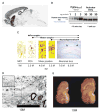Tau suppression in a neurodegenerative mouse model improves memory function
- PMID: 16020737
- PMCID: PMC1574647
- DOI: 10.1126/science.1113694
Tau suppression in a neurodegenerative mouse model improves memory function
Abstract
Neurofibrillary tangles (NFTs) are the most common intraneuronal inclusion in the brains of patients with neurodegenerative diseases and have been implicated in mediating neuronal death and cognitive deficits. Here, we found that mice expressing a repressible human tau variant developed progressive age-related NFTs, neuronal loss, and behavioral impairments. After the suppression of transgenic tau, memory function recovered, and neuron numbers stabilized, but to our surprise, NFTs continued to accumulate. Thus, NFTs are not sufficient to cause cognitive decline or neuronal death in this model of tauopathy.
Figures




References
-
- Lee VM, Balin BL, Otvos L, Jr, Trojanowski JQ. Science. 1991;251:675. - PubMed
Publication types
MeSH terms
Substances
Grants and funding
- R01 AG026252/AG/NIA NIH HHS/United States
- R01-AG26249/AG/NIA NIH HHS/United States
- T31-AG00277/AG/NIA NIH HHS/United States
- R01 AG008487/AG/NIA NIH HHS/United States
- R01-026252/PHS HHS/United States
- P50 AG005134/AG/NIA NIH HHS/United States
- P01-AG15453/AG/NIA NIH HHS/United States
- R01-NS46355/NS/NINDS NIH HHS/United States
- R01-AG08487/AG/NIA NIH HHS/United States
- R01 NS082672/NS/NINDS NIH HHS/United States
- R01 AG026249/AG/NIA NIH HHS/United States
- R01 NS046355/NS/NINDS NIH HHS/United States
- P01 AG015453/AG/NIA NIH HHS/United States
- R01 NS033249/NS/NINDS NIH HHS/United States
LinkOut - more resources
Full Text Sources
Other Literature Sources
Medical
Molecular Biology Databases

